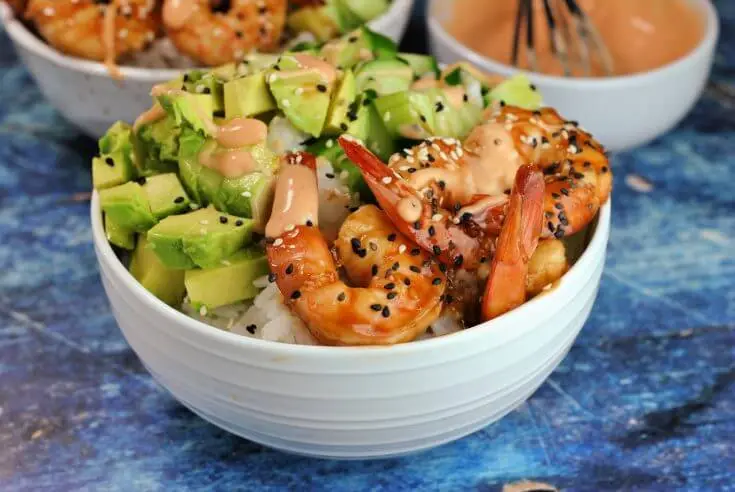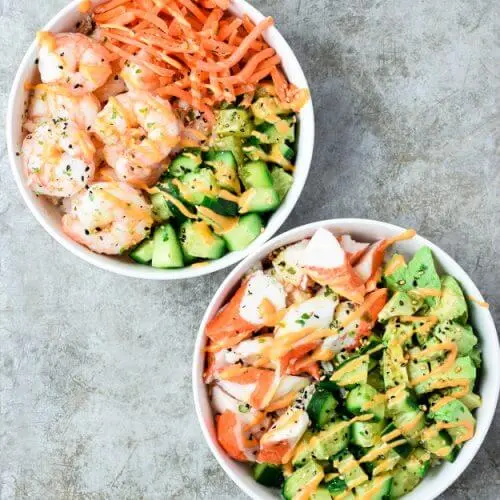Shrimp sushi bowls are a convenient and flavorful way to enjoy the essence of sushi without the complexity of rolling. These bowls typically feature a base of sushi rice, often accompanied by vegetables like avocado, cucumber, and seaweed, topped with shrimp prepared in various styles, such as spicy, teriyaki, or tempura.

What’s to love about shrimp sushi bowls:
- Convenience: Shrimp sushi bowls offer the delightful taste of sushi without the hassle of rolling. They are quick to prepare, making them an ideal meal for busy days.
- Flavor Variety: These shrimp sushi bowls combine various ingredients, such as spicy shrimp, avocado, cucumber, seaweed, and more, resulting in a rich and satisfying flavor profile.
- Customization: Shrimp sushi bowls are highly customizable. You can adjust ingredients and toppings based on personal preferences or dietary needs, whether you prefer grilled shrimp, tempura, or a different style.
- Nutrition: Packed with fresh vegetables, lean protein from shrimp, and healthy fats from avocado, these bowls are both nutritious and delicious.
- Visual Appeal: The vibrant colors and beautiful presentation of shrimp sushi bowls make them visually appealing, adding to the dining experience.
- Healthy Option: With options to include brown rice or cauliflower rice, and plenty of fresh vegetables, shrimp sushi bowls can be a healthy meal choice.
key ingredients for this recipe:
To make this recipe of spicy shrimp sushi bowls, we needed the following ingredients:
- Sushi Rice: The base of the bowl, typically seasoned with rice vinegar, sugar, and salt for authentic flavor.
- Shrimp: The main protein, which can be prepared in various ways such as spicy, teriyaki, or tempura.
- Vegetables: Common additions include avocado, cucumber, and marinated vegetables like carrots or radishes.
- Toppings: These can include seaweed (nori), sesame seeds, green onions, and pickled ginger.
- Sauces: Spicy mayo, sriracha, or teriyaki sauce for added flavor.
- Extras: Optional ingredients might include edamame, wasabi, or furikake seasoning for extra texture and taste.
The necessary tools required:
- Rice Cooker or Pot: To cook the sushi rice to the perfect texture.
- Mixing Bowls: For preparing and mixing the ingredients, including the rice seasoning and sauces.
- Cutting Board and Knife: Essential for chopping vegetables and slicing avocado.
- Measuring Cups and Spoons: To ensure the right proportions of rice vinegar, sugar, salt, and other ingredients.
- Small Pan: For cooking the shrimp, whether sautéing, grilling, or frying.
- Spatula or Mixing Spoon: Useful for stirring rice and combining ingredients.
- Serving Bowls: To assemble and serve the shrimp sushi bowls attractively.
Instructions: Step by step preparation methodology:
- Cook the Rice:
- Rinse 2 cups of sushi rice under cold water until the water runs clear.
- Cook the rice in a rice cooker or pot with 3 cups of water until tender.
- Once cooked, transfer the rice to a large bowl and let it cool slightly.
- Prepare Rice Seasoning:
- In a small bowl, mix 1/4 cup rice vinegar, 2 teaspoons sugar, and 1 teaspoon salt until dissolved.
- Pour the mixture over the warm rice and gently fold to combine. Set aside.
- Cook the Shrimp:
- In a pan, heat 1 tablespoon of oil over medium heat.
- Add 1 pound of peeled and deveined shrimp, and cook until pink and opaque, about 2-3 minutes per side.
- Season with salt and pepper, and set aside.
- Prepare Vegetables and Toppings:
- Slice 1 avocado, 1 cucumber, and 1 carrot into thin slices or matchsticks.
- Optionally, prepare other toppings like edamame, seaweed salad, and pickled ginger.
- Make Sriracha Mayo (Optional):
- In a small bowl, mix 1/4 cup mayonnaise with 1-2 tablespoons of sriracha sauce.
- Adjust the amount of sriracha to your desired spice level.
- Assemble the Bowls:
- Divide the seasoned sushi rice among serving bowls.
- Top with cooked shrimp, sliced avocado, cucumber, carrot, and other desired toppings.
- Drizzle with sriracha mayo and sprinkle with sesame seeds or furikake.
- Serve:
- Serve immediately with soy sauce and wasabi on the side.

Do I have to use pre-cooked shrimp?
You do not have to use pre-cooked shrimp for your shrimp sushi bowls. You can use either raw or pre-cooked shrimp, depending on your preference and convenience. Here are some points to consider:
- Raw Shrimp:
- Flavor and Texture: Raw shrimp can offer better flavor and texture when cooked properly. You can season them to your liking and avoid overcooking.
- Preparation: Raw shrimp needs to be deveined, peeled, and cooked. This requires a bit more time and effort but allows for more control over the final dish.
- Pre-Cooked Shrimp:
- Convenience: Pre-cooked shrimp saves time and effort as they are already cooked. They just need to be thawed and added to the dish.
- Risk of Overcooking: Be careful when reheating pre-cooked shrimp, as overcooking can make them tough and rubbery. It’s best to add them to your dish at the last moment and warm them briefly.
Make Your Sushi Bowls with a Different Protein:
Sushi bowls are versatile and can be customized with a variety of proteins to suit different dietary preferences and tastes. Here are some alternative proteins you can use:
- Tofu:
- Preparation: Marinate tofu in soy sauce, sesame oil, and garlic, then bake or sauté until crispy.
- Benefits: High in protein and suitable for vegetarians and vegans.
- Tempeh:
- Preparation: Slice tempeh thinly, marinate in soy sauce, and pan-fry until golden.
- Benefits: Fermented and packed with protein and probiotics.
- Chicken:
- Preparation: Grill or bake chicken breast seasoned with teriyaki sauce. Slice thinly before adding to the bowl.
- Benefits: A lean protein option that is widely available and easy to prepare.
- Beef:
- Preparation: Use thinly sliced beef, marinate in soy sauce and ginger, and quickly stir-fry.
- Benefits: Adds a rich flavor and is high in iron.
- Eggs:
- Preparation: Make a tamagoyaki (Japanese rolled omelette) and slice it into strips.
- Benefits: Easy to prepare and adds a unique texture to the bowl.
- Legumes:
- Preparation: Use cooked edamame or chickpeas, seasoned lightly with salt and pepper.
- Benefits: High in fiber and protein, and a great vegan option.
- Fish:
- Preparation: Use cooked or smoked fish like salmon or tuna. Alternatively, canned tuna or salmon can be a quick and easy option.
- Benefits: Rich in omega-3 fatty acids and a classic sushi ingredient.
Feel free to mix and match these proteins with your favorite sushi bowl ingredients like rice, vegetables, and sauces to create a delicious and balanced meal.
What kind of shrimp is used in sushi?
In sushi, a variety of shrimp types are used, each adding unique flavors and textures to the dish. One common type is Ebi, which is typically cooked and butterflied before being placed atop rice to make shrimp nigiri.
Ama Ebi, or sweet shrimp, is often served raw and is prized for its delicate sweetness and tender texture. Another popular preparation is shrimp tempura, where the shrimp are battered and deep-fried, adding a crispy element to sushi rolls. The choice of shrimp can significantly influence the overall taste and presentation of sushi, making it a versatile and cherished ingredient in Japanese cuisine.
